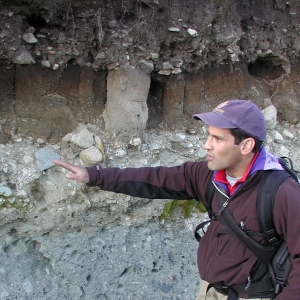Holocene Climatic Change and Active Tectonics in the Peruvian Andes: Impacts on Glaciers and Lakes
Keck Geological Consortium
Award Date: 03/26/2014 | Award Amount: $9,650 | Effective Dates: 06/15/2014 – 06/14/2015
Project Personnel: Principal Investigator Donald Rodbell (Geology); co-PI David Gillikin (Geology)
Project Summary: This proposed Keck Project is designed to tie into the final year of a 3-year NSF-funded project to generate continuous, centennial to millennial-scale records of mountain glaciation in Peru spanning the Holocene (~12 ka to present) that will enable testing of hypotheses concerning the causes of abrupt climate change in the tropics. For this Keck Project, we would like to broaden the scope to include biogeochemistry of alpine lakes and active tectonics to answer the following three project research objectives and hypotheses: Objective 1: Produce centennial-scale records of glacial flour flux using high-resolution geochemical analyses of proglacial lake sediment cores on the dry western side of the Peruvian Andes. Age models will be based on radiocarbon ages on each lake core. By developing glacial records from the dry, western side of the Andes, we will complement our existing records from the wet, eastern side, which will enable us to identify periods of changing circulation and precipitation patterns. This approach also allows us to produce separate stacked composite records of glacial variability from regions that are either precipitation or temperature sensitive. Objective 2: Determine the age of moraines using cosmogenic radionuclide (CRN) dating methods to provide information about both the timing and extent of major Holocene ice advances. While, lake sediments can provide a continuous chronology of ice advance and retreat, they do not provide information about the extent of ice during specific glacial advances. The combined lake sediment and moraine chronology approach adopted here will provide continuous records of both the timing and magnitude of glacial advances during the Holocene. Objective 3: Determine the carbon balance of Peruvian alpine lakes and calibrate lake proxy records. Paternoster lakes provide the opportunity to assess the impact of retreating ice on lake water biogeochemistry as well as calibrate lake core proxy records of ice position. As ice retreats, glacial four input into lake should decrease allowing more light to penetrate the water column thereby increasing primary productivity and carbon storage. Furthermore, glacial flour flux is used as a proxy for ice proximity, so this study will also allow us to ground truth this proxy.
College Grants & Sponsored Programs
Keck Geological Consortium Supports Holocene Climate Change
LEARN MORE ABOUT:
17 South Lane, 2nd Floor
View in Google Maps
Theresa Polson
Associate Director of College Grants and Sponsored Programs
(518) 388-6169
polsont@union.edu
Mercedes Susi
Director of College Grants and Sponsored Programs
(518) 388-6984
susim@union.edu

